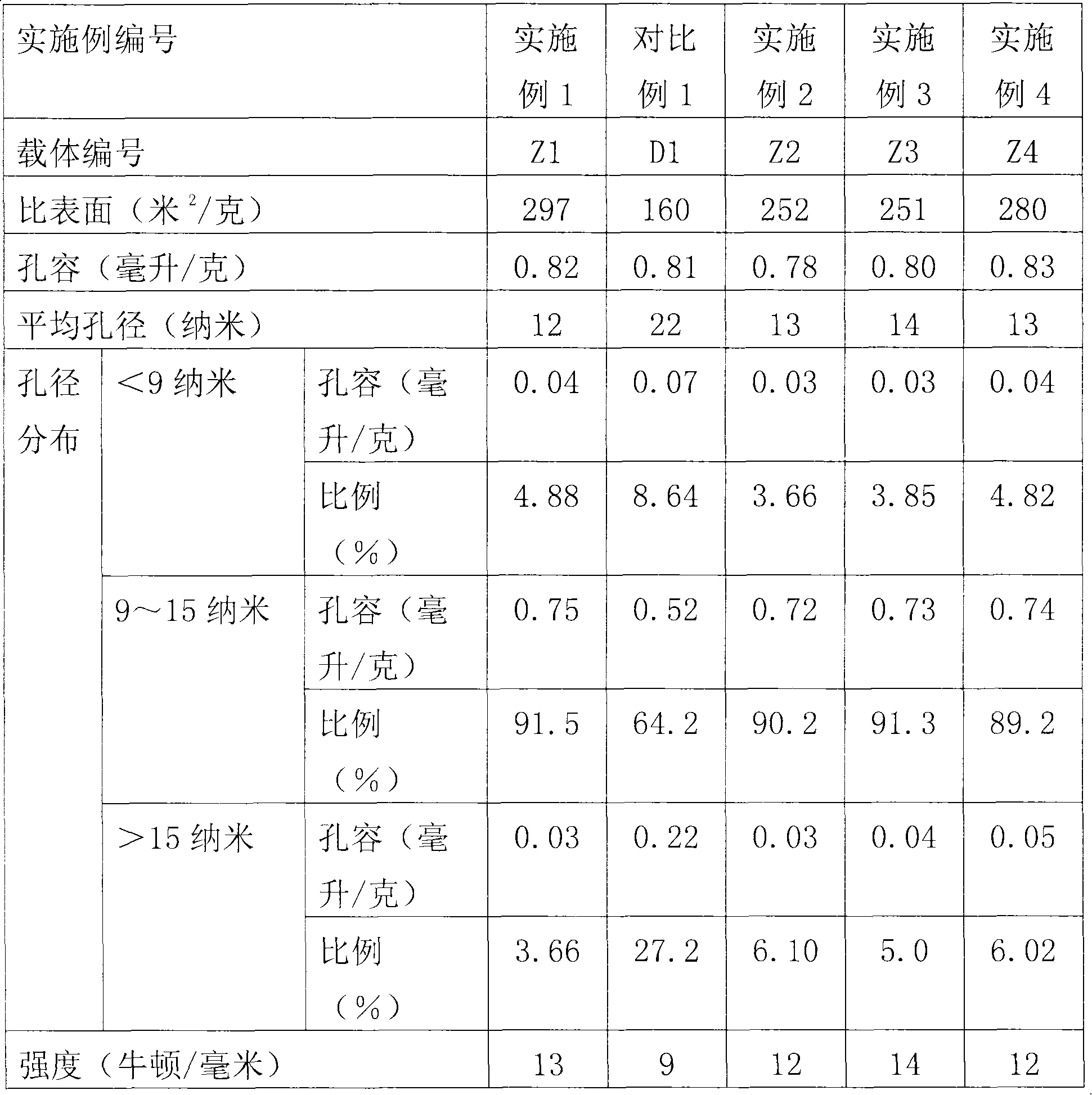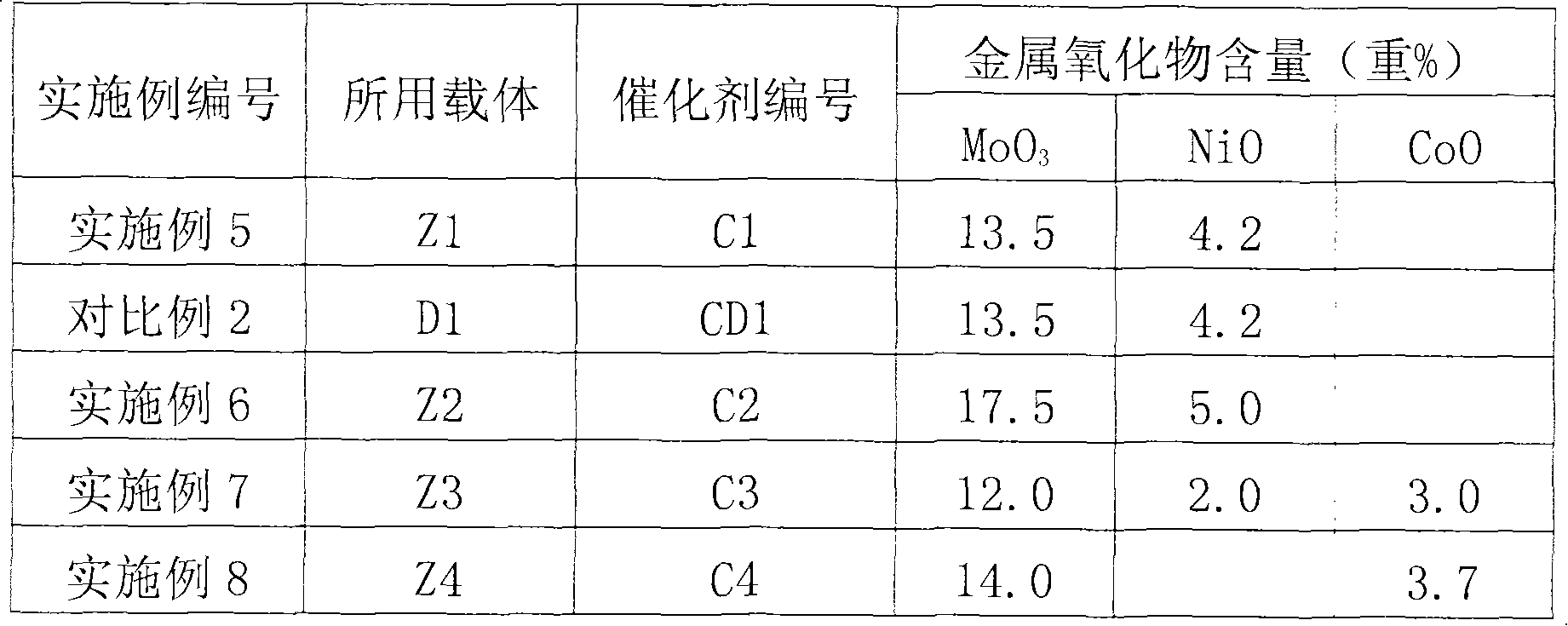Heavy oil hydrogenation processing catalyst and method for preparing same
A heavy oil hydrogenation and catalyst technology, applied in physical/chemical process catalysts, chemical instruments and methods, metal/metal oxide/metal hydroxide catalysts, etc. Pore distribution, low specific surface area, etc.
- Summary
- Abstract
- Description
- Claims
- Application Information
AI Technical Summary
Problems solved by technology
Method used
Image
Examples
preparation example Construction
[0013] The preparation method of the alumina carrier includes forming, drying, and calcining the alumina precursor, wherein the calcining conditions are: calcining at a temperature of 350-400°C for 0.5-2 hours, and then at 600-800°C. It is calcined at a temperature of ℃ for 1-6 hours.
[0014] Under preferred conditions, the firing conditions are: firing at a temperature of 350-400°C for 1-2 hours, and then firing at a temperature of 600-800°C for 2-4 hours.
[0015] The precursor of the alumina is preferably hydrated alumina. The hydrated alumina is preferably one or more of alumina trihydrate, alumina monohydrate and amorphous aluminum hydroxide. The precursor of the alumina is commercially available.
[0016] According to the method provided by the present invention, the molding can be carried out according to conventional methods, such as tablet pressing, rolling ball, extrusion, etc. For example, when extruding, the mixture can be mixed with an appropriate amount of water, an...
Embodiment 1
[0027] Mix 300 grams of pseudo-boehmite dry rubber powder (produced by Changling Catalyst Factory) and 10 grams of Sesbania powder, and mix the mixture with 360 ml of 1% nitric acid aqueous solution at room temperature. After continuous kneading into a plastic body on a twin-screw extruder, it was extruded into a trilobal strip of φ1.5 mm. The wet strip was dried at 120°C for 4 hours, then calcined at 380°C for 1 hour and 620°C for 3 hours to obtain carrier Z1 . The specific surface, pore volume and pore size distribution of Z1 were measured, and the results are shown in Table 1.
[0028] The specific surface, pore volume and pore size distribution of the carrier were determined by the BET low-temperature nitrogen adsorption method.
Embodiment 2
[0033] Mix 300 grams of pseudo-boehmite dry rubber powder (same as Example 1) and 10 grams of sesame powder, add 360 ml of 1% nitric acid aqueous solution, mix well, and continue to knead on the twin-screw extruder to make it plastic After the body, it was extruded into a butterfly-shaped strip with a diameter of 1.1 mm, and the wet strip was dried at 120°C for 2 hours, then calcined at 400°C for 1.5 hours and 700°C for 4 hours to obtain carrier Z2. The specific surface, pore volume and pore size distribution of Z2 were measured, and the results are shown in Table 1.
PUM
 Login to View More
Login to View More Abstract
Description
Claims
Application Information
 Login to View More
Login to View More - R&D
- Intellectual Property
- Life Sciences
- Materials
- Tech Scout
- Unparalleled Data Quality
- Higher Quality Content
- 60% Fewer Hallucinations
Browse by: Latest US Patents, China's latest patents, Technical Efficacy Thesaurus, Application Domain, Technology Topic, Popular Technical Reports.
© 2025 PatSnap. All rights reserved.Legal|Privacy policy|Modern Slavery Act Transparency Statement|Sitemap|About US| Contact US: help@patsnap.com



